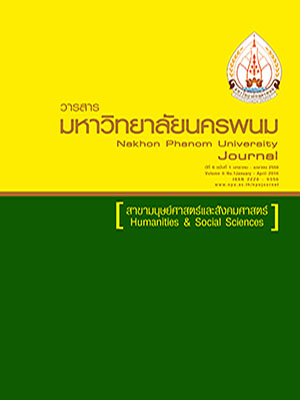พฤติกรรมการใช้สื่อสังคมออนไลน์เพื่อสนับสนุนการเรียนการสอนกรณีศึกษา รายวิชาการใช้โปรแกรมกราฟิก ของนักเรียนระดับประกาศนียบัตรวิชาชีพชั้นปีที่ 2แผนกวิชาคอมพิวเตอร์ธุรกิจ วิทยาลัยการอาชีพสว่างแดนดิน
Main Article Content
Abstract
การวิจัยครั้งนี้มีวัตถุประสงค์เพื่อ 1) ศึกษารูปแบบการใช้สื่อสังคมออนไลน์เพื่อสนับสนุนการเรียนการสอน กรณีศึกษา รายวิชาการใช้โปรแกรมกราฟิก ของนักเรียนระดับประกาศนียบัตรวิชาชีพ ชั้นปีที่ 2 แผนกวิชาคอมพิวเตอร์ธุรกิจ วิทยาลัยการอาชีพสว่างแดนดิน 2)เปรียบเทียบผลสัมฤทธิ์ทางการเรียนของนักเรียนที่ใช้สื่อสังคมออนไลน์เพื่อสนับสนุนการเรียนการสอนกับนักเรียนที่เรียนปกติในชั้นเรียนและ 3) ศึกษาความพึงพอใจในการเรียนรู้โดยใช้รูปแบบการใช้สื่อสังคมออนไลน์เพื่อสนับสนุนการเรียนการสอน เป็นการวิจัยกึ่งทดลองแบบ Two Group Spretest-Posttest Design กลุ่มตัวอย่าง คือ นักเรียนระดับประกาศนียบัตรวิชาชีพชั้นปีที่ 2 แผนกวิชาคอมพิวเตอร์ธุรกิจ วิทยาลัยการอาชีพสว่างแดนดิน 74 คน โดยเลือกแบบเจาะจง เครื่องมือที่ใช้ในการวิจัย คือ 1) สื่อสังคมออนไลน์เพื่อสนับสนุนการเรียนการสอน 2) แบบทดสอบเพื่อประเมินผลสัมฤทธิ์ทางการเรียนก่อนเรียนและหลังเรียน และ 3) แบบสอบถามเพื่อสำรวจความพึงพอใจของนักเรียนต่อรูปแบบการใช้สื่อสังคมออนไลน์เพื่อสนับสนุนการเรียนการสอน สถิติที่ใช้ในการวิเคราะห์ข้อมูล คือ ร้อยละ ค่าเฉลี่ย ส่วนเบี่ยงเบนมาตรฐาน และ การแจกแจงความถี่
ผลการวิจัยพบว่า 1) รูปแบบการใช้สื่อสังคมออนไลน์เพื่อสนับสนุนการเรียนการสอน กรณีศึกษารายวิชา การใช้โปรแกรมกราฟิกของนักเรียนระดับประกาศนียบัตรวิชาชีพชั้นปีที่ 2 แผนกวิชาคอมพิวเตอร์ธุรกิจ วิทยาลัยการอาชีพ สว่างแดนดิน มีองค์ประกอบ ดังนี้ เพศ รายได้เฉลี่ยของครอบครัวต่อเดือน ระยะเวลาการใช้สื่อสังคมออนไลน์ ช่องทางการใช้สื่อสังคมออนไลน์ เว็บไซต์ผู้ให้บริการแบ่งปันสื่อสังคมออนไลน์ วิธีการใช้สื่อสังคมออนไลน์ และ สถานที่ใช้สื่อสังคมออนไลน์ สามารถอธิบายได้ 2 รูปแบบ คือ รูปแบบที่สัมพันธ์กับ ผลสัมฤทธิ์ทางการเรียนที่สูงขึ้น และรูปแบบที่สัมพันธ์กับความพึงพอใจในการเรียน 2) ผลสัมฤทธิ์ทางการเรียนหลังเรียนของนักเรียน ที่ใช้รูปแบบการใช้สื่อสังคมออนไลน์เพื่อสนับสนุนการเรียนการสอน สูงกว่านักเรียนที่เรียนปกติในชั้นเรียน และสูงกว่าก่อนเรียน 3) ความพึงพอใจของนักเรียนต่อรูปแบบการใช้สื่อสังคมออนไลน์ เพื่อสนับสนุนการเรียนการสอน ภาพรวมอยู่ในระดับมาก (x= 3.88,S.D. = 0.48)
The purposes of this study aimed: 1) to investigate a model of using social media online to support instruction by studying the case of second year students at the level of certificate of vocational education who were enrolled in the course ‘using graphics program,’ Department of Business Computer, Sawang Daen Din Industrial and Community Education College, 2) to compare learning achievement of students who used social media online to support instruction to that of students who learned by traditional method, and 3) to examine students’ satisfaction with learning through the model of using social media online to support instruction. This study was a quasi-experimental design of two-group pretest-posttest. A sample as selected by purposive sampling was 74 second year students at the level of certificate of vocational education, Department of Business Computer, Sawang Daen Din Industrial and Community Education College. The instruments used in study were: 1) social media online to support instruction, 2) a test of learning achievement before and after learning, 3) a questionnaire for asking students’ satisfaction with the model of using social media online to support instruction. Statistics used in data analysis were percentage, mean, standard deviation, and frequency. Findings of the study were as follows : 1) The model of using social media online to support instruction by studying the case of second year students at the level of certificate of vocational education enrolled in the course ‘using graphics program,’ Department of Business Computer, Sawang Daen Din Industrial and Community Education College comprised the following components: sex, average family income per month, duration of using social media, channel of using social media online, website of those who gave social media online service sharing, method of using social media online, and place of using social media online. The model can be classified into 2 types: type 1 – high learning achievement related, and type 2 – learning satisfaction related. 2) Learning achievement of students who used the model of applying social media online to support instruction was higher than that of those who learned by traditional method and that before the treatment. 3) The students’ overall satisfaction with the model of using social media online to support instruction was at high level (x = 3.88, S.D. = 0.48)


